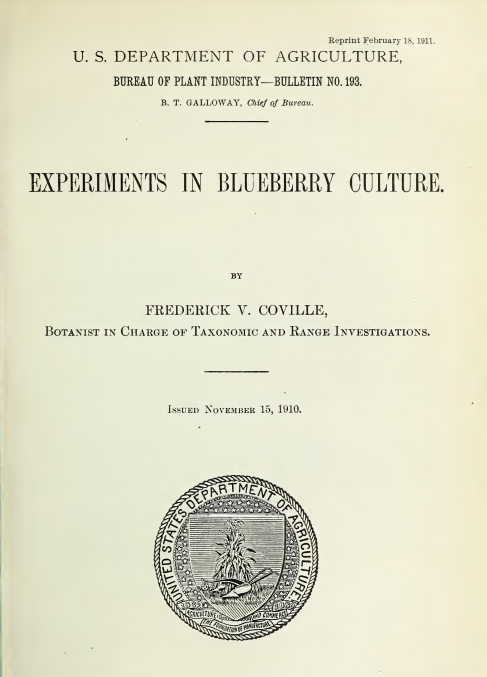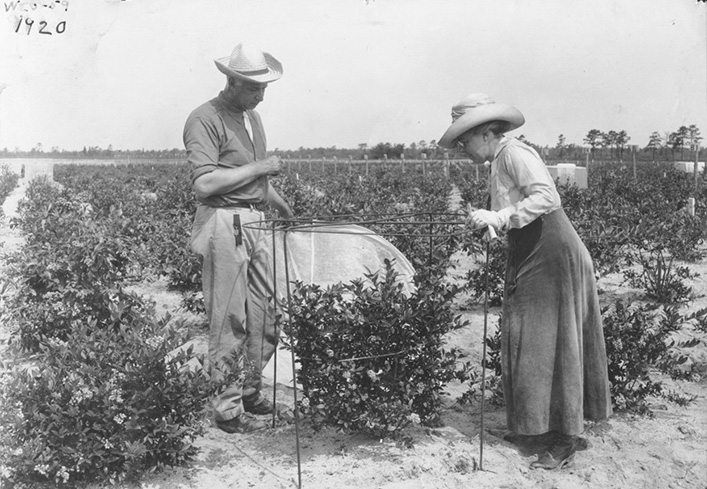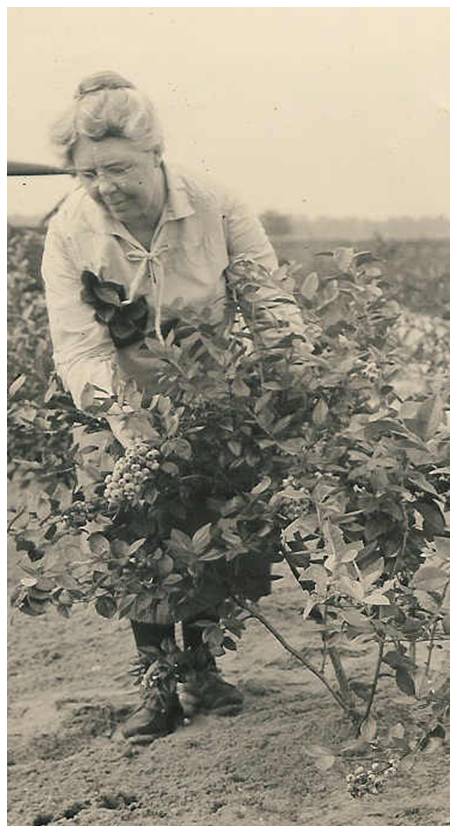There is a fascinating story about the birth of the modern cultivation of blueberry, which was born from the cross-breeding of many plants, but above all from the meeting of a researcher and a passionate person. Dr Coville's insights found fertile ground in the determination and passion of Elizabeth Coleman White, a cranberry grower who realised that the path taken by the researcher had great potential. More than 110 years later, we can see that they were both right and their insights and discoveries have borne fruit all over the world.
15 November 2020 marked the 110th anniversary of Bulletin 193 by Dr. Frederick V. Coville, U.S. Department of Agriculture, Experiments in Blueberry Culture. Prior to these studies, most attempts to transfer blueberry plants from the wild and maintain them in managed culture had been unsuccessful.

In the short time between 1906 and 1910, Coville determined that blueberries required moist but not wet soil with a low pH, had low nutrient requirements and required winter cooling. He developed propagation procedures for cuttings, grafting and budding. In 1909, he recognised that self-sterility could be a problem after few seeds and no plants resulted from self-seeding 'Brooks', an otherwise exceptional wild plant found near Greenfield, N.H.
Elizabeth C. White, a commercial grower of blueberries in Whitesbog, N.J., contacted Dr. Coville after reading 'Experiments in Blueberry Culture' and offered encouragement and assistance. The co-operation in selecting wild breeding material, growing seedlings and selecting cultivars continued for the next 26 years.
In 1920, 'Pioneer' was the first cultivar released from their breeding effort, however, 'Rubel', a wild selection that is still grown today, was released in 1912. A total of 15 cultivars were released before Coville's death in 1937. A further 14 of his crosses were released after his death. These 29 cultivars still accounted for 75% of the US commercial acreage in 1992. This early cultural work and variety development provided the basis for the commercial plantings of blueberry in New Jersey.
Interest spread to other states with the first planting in Michigan in 1924, North Carolina in 1928 and Washington in the 1930s. In 1949, there were 1,082 ha (2,674 acres) in New Jersey, 701 ha (1,731 acres) in Michigan, 230 ha (568 acres) in North Carolina, and 84 ha (207 acres) in Washington, according to the U.S. Census Bureau. Evaluation of wild selections of rabbiteye (V. ashei) began in Georgia in 1939, followed by controlled crosses and the first releases, 'Callaway' and 'Coastal' in 1950 and 'Tifblue' and 'Homebell' in 1960.
The development of highbush type bushes for hot climates began in Florida in 1948. The wild blueberry species V. darrowi was used as a parent to provide the low chilling requirement, while trying to maintain the desirable fruiting characteristics of the Northern Highbush cultivars developed by Dr. Coville. The first of these cultivars, named 'Southern highbush', 'Sharpeblue' and 'Floridablue' were released in 1976.
More recently, crosses of highbush and lowbush (V. angustifolium) have given shrubs of reduced stature ('half-highs') which are protected from snow cover. The first of these cultivars were released in Michigan, 'Northland', 1968 and Minnesota, 'Northblue' and 'Northsky', 1983. Could Fredrick Coville have imagined a crop spread over 25,500 hectares that made over $500 million to growers in the US a century later?
THE STORY OF ELIZABETH COLEMAN WHITE
Elizabeth Coleman White's efforts to cultivate blueberries (Vaccinium corymbosum) began in 1910 when she read the U.S.D.A. publication 'Experiments in Blueberry Culture', written by Dr. Fredrick V. Coville. Realising the potential value of this work, Elizabeth and her father decided to contact Coville and offer him their support.
In an interview recorded in 1953, Elizabeth recalled her experiences in this venture:
[My father and I] had talked about the possibility of adding blueberries to our cranberry crop, but we weren't the first ones to realise that we had to have a uniform product. We knew that the wild bushes were very, very different. We would go around and taste these fruits and one was too tart, one was too flat, one was too small and finally we would get to one that Dad called a peach, but we didn't know how to propagate the plant. At that time, it was said among farmers in New Jersey that blueberries could not be grown.
Despite the difficulties, Coville joined the Whites in Whitesbog, and by 1916, they had managed to grow and produce a crop of blueberries for sale. However, they could not have succeeded had it not been for the efforts of the locals, whom Miss White asked to continue their search for blueberry bushes with large berries.
These prospectors were organised under Jake Sooy or Alfred Stevenson and equipped with labels, bottles containing the preservative formalin and an aluminium gauge with a hole 5/8 inch (15.8 mm) in diameter. If a bush had at least one berry of this size or larger, it was considered a good candidate for cultivation. For their efforts, these workers were offered $2.00 per bush plus compensation for the time required to locate the plants and bring them to Whitesbog. In addition, the finders enjoyed the distinction of having the bushes they found named after them. As Miss White recalled in 1953:
In getting the first bushes, I tried to name each bush after the person who found it... and so I had the Adams bush found by Jim Adams, the Harding bush that was found by Ralph Harding, and the Dunphy bush that was found by Theodore Dunphy. When Sam Lemmon found a bush, I couldn't call it the Lemmon bush so I named it Sam. Finally, Rube Leek of Chatsworth found a bush. I didn't know it was anything special at the time and used the full name in my notes....Coville called it the Rube which seemed a poor name for an aristocratic bush. In the end he suggested calling it Rubel. And the Rubel bush was really the cornerstone of the selection of blueberries. It is the only bush of which there are hundreds of acres planted by division alone. It is still in cultivation and I still consider it a good bush. It also goes into the two or three way inheritance of all the accepted varieties today.
The acquisition of the bushes was only the first step. The following account of their propagation was published in the magazine Success in 1927:
Then we cut the bushes into pieces, sometimes up to a hundred pieces per bush. These were planted under glass in carefully prepared propagation beds. But for a long time we had very little luck with propagation; only about 10% of the plants survived. Finally, we narrowed down to six varieties that seemed in every way suitable for commercial production, Rubel, Harding, Sam, Grover, Adams & Dunfee.
Thefirst successful field plantations were probably made in 1912 at the present site of Elizabeth White's house, Suningive. The first plantations in which varieties were placed in alternate rows for the purpose of cross-pollination were made just east of this location.
Thus, out of Whitesbog's efforts came the business of propagating and selling bushes from blueberry. As the plants were sold across the country, New Jersey bushes became established in many states. The plants or varieties that were selected in this state are now grown extensively in North Carolina and Michigan, as well as in Washington, Oregon, British Columbia and New England. They are also grown in New York and Connecticut, although to a lesser extent.
The plants grown for production at Whitesbog gave considerable profits even before the bushes were fully mature. In 1927, the 60-acre crop was estimated at 64,000 quarts, or 2,000 crates. So at $10 a crate, the crop was worth $20,000. At its peak of production, Whitesbog had 90 acres (about 36 hectares) of blueberries under cultivation.
In the historic village of Whitesbog you can visit the 'Whitesbog Cranberry & Blueberry Museum' where tools, equipment and memorabilia from the production of blueberries over the last hundred years are preserved.
Taken from:
- Charles M. "Mike" Mainland (2012) Frederick V. Coville and the History of North American Highbush Blueberry Culture, International Journal of Fruit Science, 12:1-3, 4-13, DOI: 10.1080/15538362.2011.619117
- Whitesbog: Blueberry cultivation

















